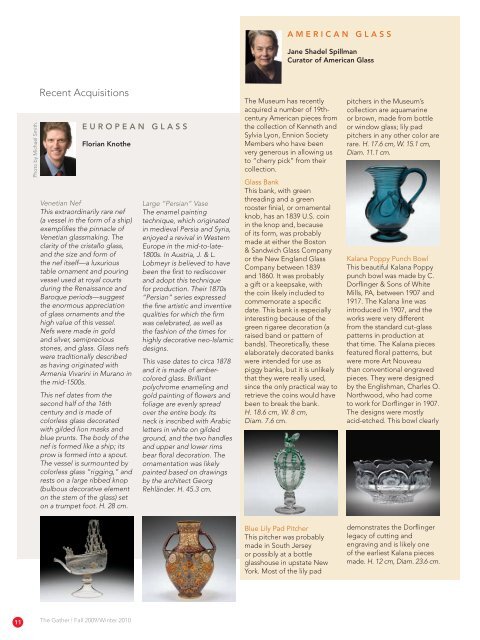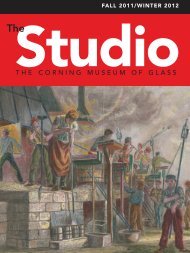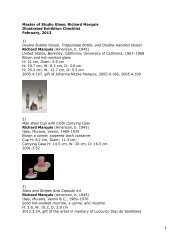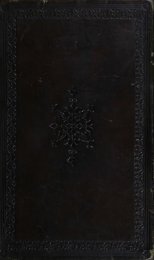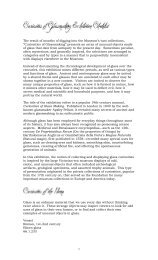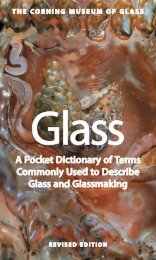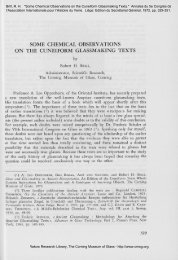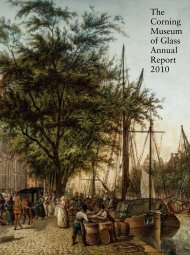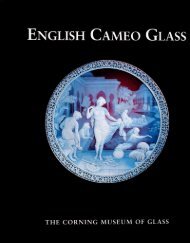The Gather - Corning Museum of Glass Members' Magazine (Fall ...
The Gather - Corning Museum of Glass Members' Magazine (Fall ...
The Gather - Corning Museum of Glass Members' Magazine (Fall ...
Create successful ePaper yourself
Turn your PDF publications into a flip-book with our unique Google optimized e-Paper software.
11<br />
Photo by Michael Smith.<br />
Recent Acquisitions<br />
EUROPEAN GLASS<br />
Florian Knothe<br />
Venetian Nef<br />
This extraordinarily rare nef<br />
(a vessel in the form <strong>of</strong> a ship)<br />
exemplifies the pinnacle <strong>of</strong><br />
Venetian glassmaking. <strong>The</strong><br />
clarity <strong>of</strong> the cristallo glass,<br />
and the size and form <strong>of</strong><br />
the nef itself—a luxurious<br />
table ornament and pouring<br />
vessel used at royal courts<br />
during the Renaissance and<br />
Baroque periods—suggest<br />
the enormous appreciation<br />
<strong>of</strong> glass ornaments and the<br />
high value <strong>of</strong> this vessel.<br />
Nefs were made in gold<br />
and silver, semiprecious<br />
stones, and glass. <strong>Glass</strong> nefs<br />
were traditionally described<br />
as having originated with<br />
Armenia Vivarini in Murano in<br />
the mid-1500s.<br />
This nef dates from the<br />
second half <strong>of</strong> the 16th<br />
century and is made <strong>of</strong><br />
colorless glass decorated<br />
with gilded lion masks and<br />
blue prunts. <strong>The</strong> body <strong>of</strong> the<br />
nef is formed like a ship; its<br />
prow is formed into a spout.<br />
<strong>The</strong> vessel is surmounted by<br />
colorless glass “rigging,” and<br />
rests on a large ribbed knop<br />
(bulbous decorative element<br />
on the stem <strong>of</strong> the glass) set<br />
on a trumpet foot. H. 28 cm.<br />
<strong>The</strong> <strong>Gather</strong> | <strong>Fall</strong> 2009/Winter 2010<br />
Large “Persian” Vase<br />
<strong>The</strong> enamel painting<br />
technique, which originated<br />
in medieval Persia and Syria,<br />
enjoyed a revival in Western<br />
Europe in the mid-to-late-<br />
1800s. In Austria, J. & L.<br />
Lobmeyr is believed to have<br />
been the first to rediscover<br />
and adopt this technique<br />
for production. <strong>The</strong>ir 1870s<br />
“Persian” series expressed<br />
the fine artistic and inventive<br />
qualities for which the firm<br />
was celebrated, as well as<br />
the fashion <strong>of</strong> the times for<br />
highly decorative neo-Islamic<br />
designs.<br />
This vase dates to circa 1878<br />
and it is made <strong>of</strong> ambercolored<br />
glass. Brilliant<br />
polychrome enameling and<br />
gold painting <strong>of</strong> flowers and<br />
foliage are evenly spread<br />
over the entire body. Its<br />
neck is inscribed with Arabic<br />
letters in white on gilded<br />
ground, and the two handles<br />
and upper and lower rims<br />
bear floral decoration. <strong>The</strong><br />
ornamentation was likely<br />
painted based on drawings<br />
by the architect Georg<br />
Rehländer. H. 45.3 cm.<br />
<strong>The</strong> <strong>Museum</strong> has recently<br />
acquired a number <strong>of</strong> 19thcentury<br />
American pieces from<br />
the collection <strong>of</strong> Kenneth and<br />
Sylvia Lyon, Ennion Society<br />
Members who have been<br />
very generous in allowing us<br />
to “cherry pick” from their<br />
collection.<br />
<strong>Glass</strong> Bank<br />
This bank, with green<br />
threading and a green<br />
rooster finial, or ornamental<br />
knob, has an 1839 U.S. coin<br />
in the knop and, because<br />
<strong>of</strong> its form, was probably<br />
made at either the Boston<br />
& Sandwich <strong>Glass</strong> Company<br />
or the New England <strong>Glass</strong><br />
Company between 1839<br />
and 1860. It was probably<br />
a gift or a keepsake, with<br />
the coin likely included to<br />
commemorate a specific<br />
date. This bank is especially<br />
interesting because <strong>of</strong> the<br />
green rigaree decoration (a<br />
raised band or pattern <strong>of</strong><br />
bands). <strong>The</strong>oretically, these<br />
elaborately decorated banks<br />
were intended for use as<br />
piggy banks, but it is unlikely<br />
that they were really used,<br />
since the only practical way to<br />
retrieve the coins would have<br />
been to break the bank.<br />
H. 18.6 cm, W. 8 cm,<br />
Diam. 7.6 cm.<br />
Blue Lily Pad Pitcher<br />
This pitcher was probably<br />
made in South Jersey<br />
or possibly at a bottle<br />
glasshouse in upstate New<br />
York. Most <strong>of</strong> the lily pad<br />
AMERICAN GLASS<br />
Jane Shadel Spillman<br />
Curator <strong>of</strong> American <strong>Glass</strong><br />
pitchers in the <strong>Museum</strong>’s<br />
collection are aquamarine<br />
or brown, made from bottle<br />
or window glass; lily pad<br />
pitchers in any other color are<br />
rare. H. 17.6 cm, W. 15.1 cm,<br />
Diam. 11.1 cm.<br />
Kalana Poppy Punch Bowl<br />
This beautiful Kalana Poppy<br />
punch bowl was made by C.<br />
Dorflinger & Sons <strong>of</strong> White<br />
Mills, PA, between 1907 and<br />
1917. <strong>The</strong> Kalana line was<br />
introduced in 1907, and the<br />
works were very different<br />
from the standard cut-glass<br />
patterns in production at<br />
that time. <strong>The</strong> Kalana pieces<br />
featured floral patterns, but<br />
were more Art Nouveau<br />
than conventional engraved<br />
pieces. <strong>The</strong>y were designed<br />
by the Englishman, Charles O.<br />
Northwood, who had come<br />
to work for Dorflinger in 1907.<br />
<strong>The</strong> designs were mostly<br />
acid-etched. This bowl clearly<br />
demonstrates the Dorflinger<br />
legacy <strong>of</strong> cutting and<br />
engraving and is likely one<br />
<strong>of</strong> the earliest Kalana pieces<br />
made. H. 12 cm, Diam. 23.6 cm.


